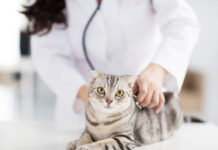Events in the world of infectious diseases have been hitting the headlines recently, and because they involve cats, Id like to discuss them in this column rather than answering questions from CatWatch readers (just this once, I promise).
Superbugs: Is there a human/cat connection?
Staphylococcus aureus is a common bacterium that lives on the skin and in the noses of people and other animals, usually without much consequence. But human infection with a certain form of the bacterium, methicillin-resistant Staphylococcus aureus (MRSA) – one of the so-called superbugs that resist many commonly used antibiotics – is linked to over 125,000 human hospitalizations in the United States every year. (Check the CDC website, www.cdc.gov/ncidod/aip/research/mrsa.html#what_is_staph, for more information.)
MRSA infection in dogs and cats is considered rare, but some studies suggest that passage of the bacterium between humans and household pets is possible. Results of a recent scientific study from the Ontario Veterinary College (OVC) in Canada are bound to raise additional concerns among cat lovers. The report, entitled Suspected transmission of methicillin-resistant Staphylococcus aureus between domestic pets and humans in veterinary clinics and in the household, is scheduled to appear in an upcoming issue of the journal, Veterinary Microbiology. Researchers heading up the study found the same type of MRSA in five infected dogs and three infected cats as they found in some of the people in close contact with the infected animals. Most, if not all, of the infected people were healthy at the time and according to the researchers these results suggest that MRSA can be transmitted between humans and animals many times within a household or veterinary clinic… and support previous concerns that pets could become household reservoirs of MRSA…. Interestingly, some studies suggest that pets most likely become initially infected from people rather than vice versa.
So should cat lovers panic? Certainly not. But studies like this reinforce something weve known for a long time: Animals and people share many infectious agents (called zoonotic agents). In most cases, common sense and good hygiene will go a long way toward keeping you, your family and your cat free of zoonotic diseases.
Its likely that washing hands before eating and after handling your cats, seeking immediate veterinary care for sick cats, and preventing your cats from licking your face, food utensils or plates will minimize the chances of your sharing any bacteria, potentially harmful or otherwise, with your cat. (For additional information about zoonotic diseases and their prevention, see Zoonotic Disease: What Can I Catch from My Cat? developed by the Cornell Feline Health Center and the American Association of Feline Practitioners at www.vet.cornell.edu/fhc/resources/brochure/ZoonoticDisease.html.)
More on cats and avian influenza
My column in the December, 2005 issue of CatWatch was devoted to avian influenza and cats, so readers should check that issue for more details. But recent reports from Germany of a cat found dead due to a highly pathogenic avian influenza virus infection have fueled more concerns, as has a study, Influenza A Virus (H5N1) Infection in Cats Causes Systemic Disease with Potential Novel Routes of Virus Spread within and between Hosts, (American Journal of Pathology, Vol. 168, No. 1, http://ajp.amjpathol.org/cgi/content/full/168/1/176) published in January, 2006. This study more fully described the disease in cats, further confirmed that domestic cats can be infected by eating infected birds, and that infected cats can spread infection to other cats, most likely through feces, urine and secretions from the respiratory tract. As noted in the December column, there is currently no evidence that influenza-infected cats can in turn infect humans – an important point to remember.
The German cat mentioned earlier is believed to have eaten one of the H5N1-infected wild birds recently found in the same part of the country. At the time of this writing, the H5N1 virus is not present in the United States. If H5N1 or an equally harmful influenza virus were to appear, the safeguards established by governmental agencies should help to prevent the kinds of outbreaks that have occurred in other parts of the world. For these reasons, the risk to cats in this country is considered very low.
But two additional safeguards can reduce the already low risk of feline infection. First, dont feed uncooked poultry to cats. Since the virus is destroyed at 70 C, the high temperatures required to manufacture commercial cat foods eliminates the risk of infection in cats exclusively fed these foods. Second, keep cats indoors to prevent them from eating infected birds; because cat-to-cat infection is possible, this measure has the added advantage of preventing exposure to potentially infected outdoor cats.



